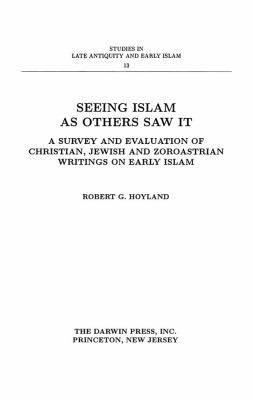9.2 /10 1 Votes9.2
Publication date 1997 Originally published 1997 Page count 872 Dewey decimal 939.4 | 4.6/5 Goodreads Publisher Darwin Press Media type Hardcover OCLC 36884186 | |||||||||||||||||||||||||||||||||
 | ||||||||||||||||||||||||||||||||||
Subject Islamic Empire--History--622-661--Historiography.Islamic Empire--History--661-750--Historiography.Middle East--Civilization--To 622--Historiography. Islam books Hagarism, The Death of a Prophet, Crossroads to Islam, Narratives of Islamic Origins, Witnesses to a World Crisis: Hi | ||||||||||||||||||||||||||||||||||
Seeing Islam As Others Saw It: A Survey and Evaluation of Christian, Jewish and Zoroastrian Writings on Early Islam from the Studies in Late Antiquity and Early Islam series is a book by scholar of the Middle East Robert G. Hoyland.
Contents
- Syriac texts
- Greek texts
- Hebrew texts
- Persian texts
- Muslim Arabic texts
- Armenian texts
- Latin texts
- Christian Arabic texts
- Jewish texts
- References
The book contains an extensive collection of Greek, Syrian, Coptic, Armenian, Latin, Jewish, Persian, and Chinese primary sources written between 620 and 780 AD in the Middle East, which provides a survey of eyewitness accounts of historical events during the formative period of Islam.
The book presents the evidentiary text of over 120 seventh century manuscripts, one of which (the manuscript of Thomas the Presbyter) contains what Hoyland believes is the "first explicit reference to Muhammad in a non-Muslim source:"
In the year 945, indiction 7, on Friday 7 February (634) at the ninth hour, there was a battle between the Romans and the Arabs of Muhammad (tayyaye d-Mhmt) in Palestine twelve miles [19 km] east of Gaza. The Romans fled, leaving behind the patrician Bryrdn, whom the Arabs killed. Some 4000 poor villagers of Palestine were killed there, Christians, Jews and Samaritans. The Arabs ravaged the whole region.According to Michael G. Morony, Hoyland emphasizes the parallels between Muslim and non-Muslim accounts of history emphasizing that non-Muslim texts often explain the same history as the Muslim ones even though they were recorded earlier. He concludes "Hoyland's treatment of the materials is judicious, honest, complex, and extremely useful."
